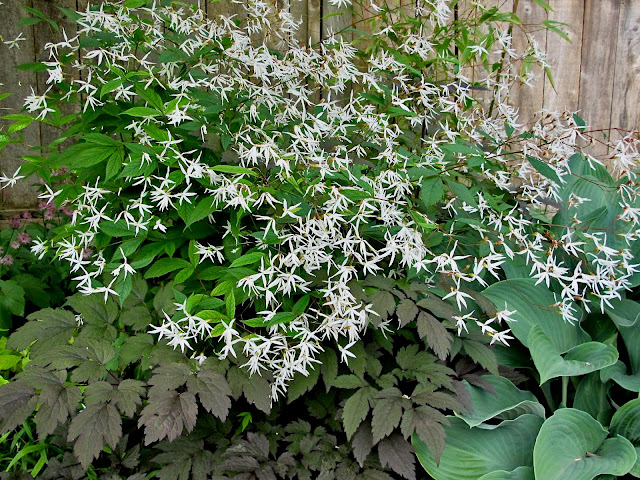Gardens are rich in many different colours during the summer months, but just to continue the colour theme I started in April, I'm going to focus on white for this post.
Ranuculus aconitifolius 'Flore Pleno'is a long name for a small button of a flower. What it lacks in individual size, however, it makes up for in generosity of blooms.
Although it is a member of the buttercup family, it doesn't run. I have two plants side by side each making a sturdy clump that remains quite narrow at the base while spreading twice as wide at the top to make a cloud of bloom. I find that quite a few white flowers turn an unattractive pink as they age, but this perennial stays fresh-looking right until it starts to die. Various sources recommend it for boggy areas and it could probably use more water than it gets in my garden, but it doesn't seem to mind.
Brightening the shade garden in late June, Gillenia trifoliata spreads its constellation of dainty white stars over its lower neighbours. Reddish stems and calyces only heighten its pristine effect. It was a surprise to learn that it's a member of the rose family.
By the end of July it will have completed its bloom cycle and be overpowered in its turn by the dark leaves of Actea 'Hillside Black Beauty' and the pleated green ones of Hosta 'Krossa Regal'.
Also enjoying the shade is Astrantia major, whose flowers have a more substantial presence. The stamens start out pink but gradually turn greenish-white like the central flower in this cluster.
This particular plant is self-sown as the Astrantia family is inclined to do, but plants that will flower in dark corners are not common and its easy to edit out unwanted seedlings.
Another shade lover is my tree hydrangea (Hydrangea aspera ssp. sargentiana) Its flowers are actually the tiny purple dots in the centre, but I'm including it here for the fringe of pristine white bracts that give each bloom the look of an exploding firework.









